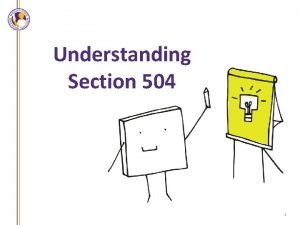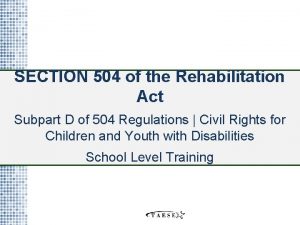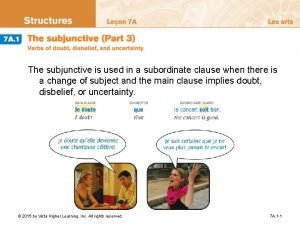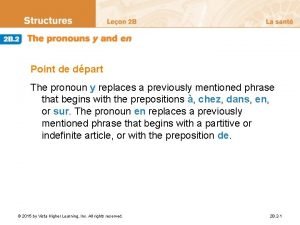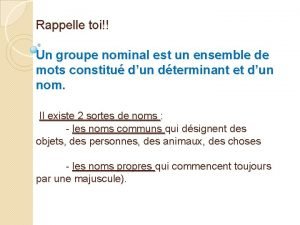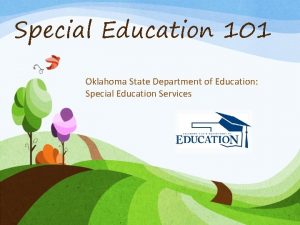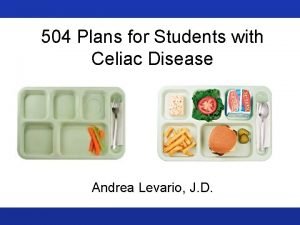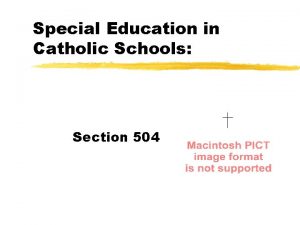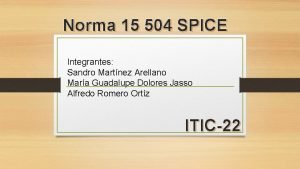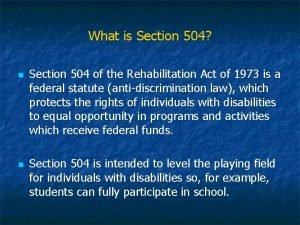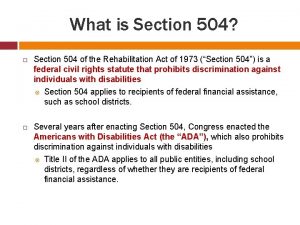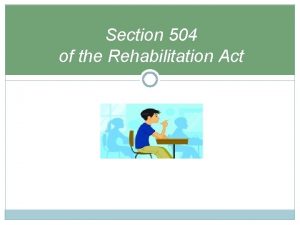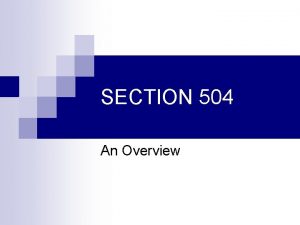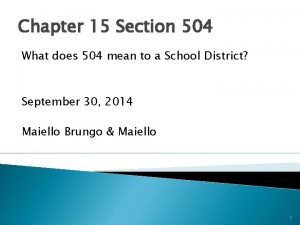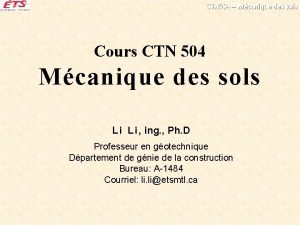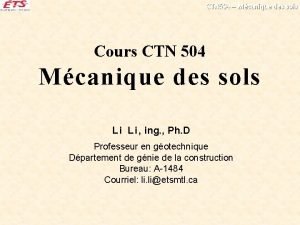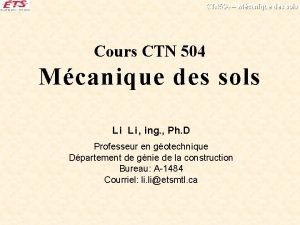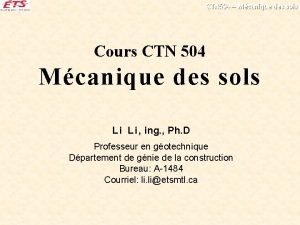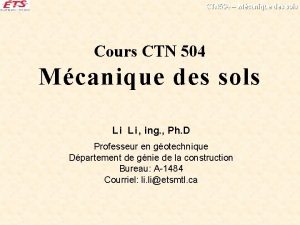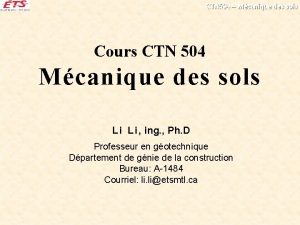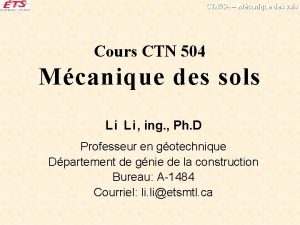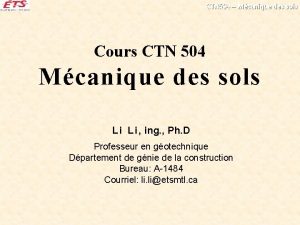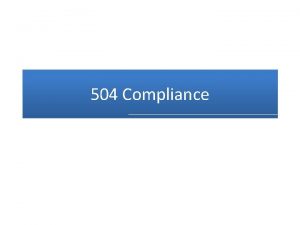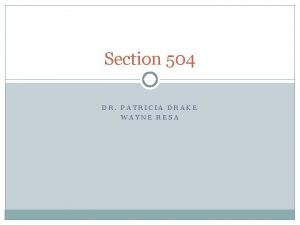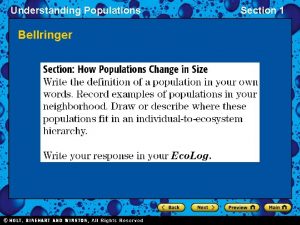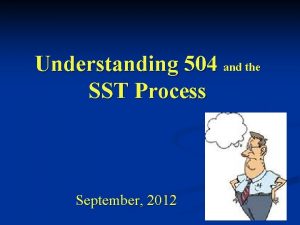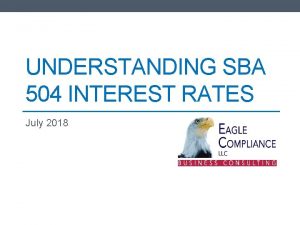Understanding Section 504 SECTION 504 Est As Part

































- Slides: 33

Understanding Section 504

SECTION 504 Est. As Part of the Rehabilitation Act of 1973 • “No otherwise qualified individual with handicaps in the United States shall solely by reason of his/her handicap, as defined in Section 706(8) of this title, be excluded from the participation in, be denied the benefits of, or be subjected to discrimination under any program or activity receiving federal financial assistance or under any program or activity conducted by any executive agency or by the United States Postal Service. ” • (29 U. S. C. Sec. 794) ®

Section 504 Three Prong Eligibility Standard A Student who: Has a (1) physical or mental impairment which (2) substantially limits (3) one or more major life activities;

What is a Physical or Mental Impairment Under Section 504? � � Any physiological disorder or condition, cosmetic disfiguration, or anatomical loss. Any mental or psychological disorder. Section 504 does not define specific impairments. Examples include behavior disorders, ADD/ADHD, HIV/AIDS, diabetes, asthma, physical disabilities, allergies, hearing impairments.

Section 504: Disability Defined Major Life Activities** Record of Impairment** Regarded Impairment** Major life activities include: The individual has: • A history of impairment • An impairment not limiting a major life activity, but treated as disabled by the covered entity Physical or Mental Impairment** Physiological disorder, contagious disease, cosmetic disfigurement or anatomical loss in one or more system: • • • Neurological Musculoskeletal Respiratory Cardiovascular Reproductive Digestive Genito-urinary Hemic Lymphatic Skin Endocrine Mental or psychological disorder including: • Mental retardation • Organic brain syndrome • Emotional or mental illness • Specific learning disabilities • • • • Self-care Manual tasks Walking Seeing Hearing Speaking Breathing Sitting Standing Thinking Concentrating Reaching Interacting with others • Learning • Working • recovering alcoholic or addict* * Does not include current, illegal drug abusers. 104. 3) or • A record of having been misclassified as having an impairment or • No impairment, but treated as disabled by the covered entity ** (34 Code of Fed Reg. Part

What does “Substantially Limit” Mean Under Section 504? � � � Determining whether an impairment is substantially limiting is critical to deciding Section 504 eligibility. Regulations fail to provide a definition for the term “substantial limits”. Case law establishes that “substantial limits” means unable to perform or significantly restricted in performing a major life activity as compared to the average student.

What Constitutes a “Major Life Activity” Under Section 504? Learning is not the sole major life activity that may qualify a student for services. Functions as caring for one’s self; Performing manual tasks; Other activities such as walking, seeing, hearing, speaking, breathing, learning and working. Thinking, concentrating, reading

Section 504 Disability Defined Major Life Activities** Major life activities include: ® ® ® ® Self-care Manual tasks Walking Seeing Hearing Speaking Breathing Sitting ® ® ® ® Standing Reaching Thinking Concentrating Interacting with others Learning Working ** (34 Code of Fed Reg. Part 104. 3)

What About Temporary Disabilities? Determination must be made on a case-by-case basis, taking into consideration the severity and the duration of the impairment. The physical or mental impairment at issue must be permanent or anticipated to be very long term. Temporary, non-chronic impairments should generally not trigger Section 504 eligibility, i. e. , broken arm, surgery, temporary at-home medical status. Most temporary disabilities can be addressed via regular education services, i. e. , homebound, make-up work, minor classroom/environment accommodations. Pregnancy is generally not a qualifying disability unless unexpected complications arise.

Points to Remember When Considering Section 504 Eligibility � High standard to meet for Section 504 eligibility � On the average, only 1 -2% of the student population of any school is deemed Section 504 eligible. � Learning difficulties not always due to a physical or mental impairment. � Student will forever have a record of being divided. � Section 504 eligibility is not for “at-risk” students. � Phrase “substantially limits” is in present indicative verb form. Thus, student must be presently, not potentially or hypothetically, substantially limited.

Points to Remember When Considering Section 504 Eligibility � Common regular education interventions may eliminate existence of a “substantial limitation”. � Section 504 is not a consolation prize for students not qualifying for I. D. E. A. � � � Factors which may mitigate the impact of the student’s disability cannot be considered (prosthesis, medication, hard work, parental assistance) except for eyeglasses. Standard is to compare student to an “average student”. This means you compare student against chronological peers in the entire state or country. Standard is not whether the student is reaching his own potential or parent’s expectations.

Points to Remember When Considering Section 504 Eligibility � � A student with average grades is probably not Section 504 eligible in the area of learning. Physician or psychologist opinion as to student’s eligibility status is only one source of information the team should consider. Remember, the team is making an educational decision not a medical decision. Physician or psychologist, while helpful in providing documentation of a physical or mental impairment, is not qualified to opine whether that impairment “substantially limits” a major life activity in a school setting. A mere medical diagnosis is not enough for eligibility. Students eligible under I. D. E. A. are not entitled to a separate Section 504 plan. If student qualifies for special education, the parent may not “choose” one or the other.

Levels of Service ê General Education ê Section 504 ê I. D. E. A.

IDEA/504 Students Student Population Students are qualified under one or more of thirteen (14) IDEA disabling conditions. Specially designed individual education programs are planned for each student by IEP teams. Section 504 Students Only Regular education only students 504 only students IDEA & 504 students Due to substantial mental or physical impairments that limit one or more of the student’s major life activities, special accommodations to the student’s program are required. A 504 accommodation plan is designed for each student according to individual need. Examples of potential 504 disabling conditions not typically covered under IDEA are: ® communicable diseases – HIV, tuberculosis ® medical conditions – asthma, allergies, diabetes, heart disease ® temporary medical conditions due to illness or accident ® Attention Deficit Disorder (ADD, ADHD) ® recovering alcoholics and addicts ® other conditions

A GUIDING QUOTATION “Some kids need special education… Others need something special in their education. ” Education Week, June, 1998

What Does This Mean to Schools? Section 504 plan decisions must be made by a team that: ® is multi-disciplinary ® is knowledgeable about the student ® is knowledgeable about the condition. If there is a medical/health condition, invite the nurse ® considers a variety of documented information: ü ü ü Teacher recommendations Reports on the student’s physical condition The student’s social /emotional behavior

What Does This Mean to Schools? The evaluation conducted by the team must be nondiscriminatory: ® Instruments used must be valid for the purpose in question and must be administered by trained personnel. ® Must assess specific areas of need not just general intelligence, i. e. , academic, social, emotional, fine and/or gross motor skills, etc. ® Must reflect aptitude not sensory limitations or lack of English language fluency. ® The plan must be individualized. ® The evaluation must be conducted before initial placement and a subsequent significant change in

What Does This Mean to Schools? The plan may consider: ® ® ® The classroom Lesson presentation Test taking Behaviors Integrated support services ® ® Instructional support Assignments Organization Nursing considerations Transportation Reasonable accommodations to remove barriers to the educational program are selected (not negotiated like an IEP) by a multi-disciplinary team. ® The student, where feasible should attend the meeting ® Invite the parent(s)/guardian(s) to the meeting(s). (this is wise although not required by law) ®

III. EXAMPLES OF 504 ACCOMMODATIONS

Example of 504 Accommodations Seat child away from the doors/windows Group for cooperative learning Give both oral and written directions Ask frequent questions Simplify or shorten directions Reduce number of items on a task Highlight relevant words/features Increase allocated time Have student repeat directions Have student summarize at end of lesson

Example of 504 Accommodations Use timers to show allocated time � Tape record directions � Tape record student responses � Use a study guide � Provide daily and weekly assignment sheets � Provide anticipated cues � Provide visual cues � Establish rules and review frequently � Enlarge or highlight key words on test items � Provide essential fact list �

Example of 504 Accommodations Provide pencil grips � Put desk close to blackboard � Tape paper to desk � Repeat major points � Call student’s name before asking a question � Provide content/lecture summaries � Use computer for writing tasks � Use peer-mediated strategies (“buddy system”) � Pause during speaking � Use self-teaching materials �

Tips For an Effective and Legally Compliant Section 504 Eligibility Meeting

A. Prior to the Meeting: Ensure That All Procedural Requirements Are Met � � � Notice to parent of evaluation, meetings, and notice of results/actions taken at 504 meeting. Appropriate Team Membership Parent Persons knowledgeable about the child, meaning of evaluations, and placement options. Persons knowledgeable about the mental condition Parent Rights must be provided. Parent Permission must be received prior to evaluation. Ensure appropriate time limits are met. - Sixty day referral to eligibility timeline - Ninety day referral to placement timeline

B. Properly Prepare for the Section 504 Meeting School representatives and parents should organize and review all data prior to Section 504 meeting. Bring copies of all relevant medical records. Determine whether any initial evaluation/testing suggests the need for additional evaluations.

C. Section 504 team in determining eligibility should utilize data from a variety of sources Examples: � Health records � Standardized test scores/class test scores � Informal checklists � Report cards � Parent/teacher reports and observations � Student work samples/student input � Disciplinary records � Prior special education testing results (if student is not eligible for special education) � Cumulative records � All data considered by team must be documented. � Reason for referral must be appropriately addressed by evaluation data. � Good information guides accurate eligibility decisions.

D. Developing a Section 504 Plan Identify student’s disability, the major life activity impacted by the disability, the barrier that it causes, that limits the student’s access to your educational program. Be sure that the accommodation(s) to remove the barrier, so that the student can access your educational program, is succinct and realistic. Indicate the exact amount of time when extending time for tests, and classroom/homework assignments.

E. Periodic Review The school should review a student’s Section 504 plan at least on an annual basis or upon any significant change in placement.

Common Errors Eligibility Ignoring impairment requirement to create an unfair advantage Accepting argument that disability = eligibility ( It does not) Accepting that medical diagnosis = 504 eligibility (It does not)

Eligibility Errors Accepting that a student on medication is automatically eligible (he/she is not) Automatically excluding a temporary disability Allowing a choice between 504 and IDEA Creating a “crystal ball” eligibility Failure to dismiss when eligibility does not exist

Section 504 Child Find Requirement � � � The District has an affirmative duty to conduct a “child find” at least annually. Schools must “identify and locate” every qualified disabled child residing in jurisdictions including pre -schoolers, homeless, and those attending private school. Teachers and administrators must receive training on the identification of students suspected of having a disability.

Section 504 School Wide Compliance Requirements 1. 2. 3. 4. Provide written assurances of non-discrimination wherever the LEA receives federal money. Designate an employee to coordinate its efforts to comply with Section 504. Follow the district grievance procedure to resolve complaints alleging any action prohibited by federal regulations. Provide notice to students, parents, employees of nondiscrimination in admission or access to or treatment or employment in, its programs or activities.

QUESTIONS? Please contact: Karen Bess Student Services Washington County School District Karen. bess@washk 12. org (435) 673 -3553 ext. 5164
 Section 502 guaranteed rural housing loan program
Section 502 guaranteed rural housing loan program Section 504 home repair program
Section 504 home repair program Section 504
Section 504 Bridge loan
Bridge loan Section 504
Section 504 Renard roux bébé
Renard roux bébé Il est douteux que le metteur en scène où est l’acteur.
Il est douteux que le metteur en scène où est l’acteur. Poil de sanglier
Poil de sanglier Papa est au garage? oui, il 1 of 1 est.
Papa est au garage? oui, il 1 of 1 est. Le grain qui meurt a porté fruit partition
Le grain qui meurt a porté fruit partition Je suis tu es il est nous sommes
Je suis tu es il est nous sommes Qu'est ce que c'est
Qu'est ce que c'est Total float= * 1 point lst-est lst-eft est-lft eft-lst
Total float= * 1 point lst-est lst-eft est-lft eft-lst Seul le silence est grand tout le reste est faiblesse
Seul le silence est grand tout le reste est faiblesse Mon dieu tu es grand tu es beau paroles
Mon dieu tu es grand tu es beau paroles Dieu vivant dieu très haut
Dieu vivant dieu très haut Je suis tu es il est
Je suis tu es il est Kochelsee
Kochelsee Qu'est ce que c'est
Qu'est ce que c'est Ce n'est pas une image juste c'est juste une image
Ce n'est pas une image juste c'est juste une image Groupe nomiaux
Groupe nomiaux Les verbe d'état
Les verbe d'état Subjonctif
Subjonctif Je contiens du sucre sans être sucré qui suis-je
Je contiens du sucre sans être sucré qui suis-je Parfois je suis fort parfois je suis faible
Parfois je suis fort parfois je suis faible Staubgrenzwert
Staubgrenzwert Idea vs 504
Idea vs 504 Factorizacion prima de 135
Factorizacion prima de 135 504 plan oklahoma
504 plan oklahoma Celiac 504 plan
Celiac 504 plan 504 plan catholic schools
504 plan catholic schools Html 504
Html 504 Manifestation meeting for 504
Manifestation meeting for 504 Norma spice
Norma spice


